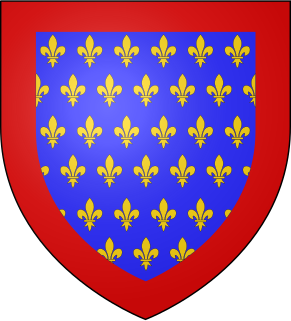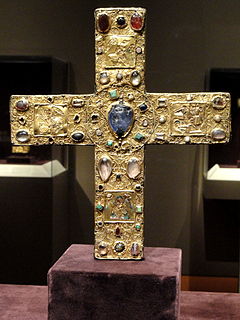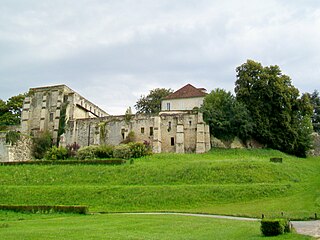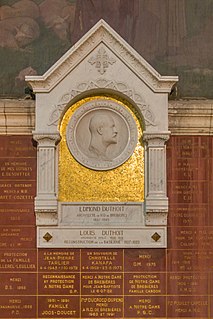Related Research Articles

Blanche of Navarre, was a French princess and Infanta of Navarre as a member of the House of Évreux and by marriage Queen consort of France from 29 January until 22 August 1350.

The Valois was a region in the valley of the Oise river in Picardy in the north of France. It was a fief in West Francia and subsequently the Kingdom of France until its counts furnished a line of kings, House of Valois, to succeed the House of Capet in 1328. It was, along with the counties of Beauvais, the Vexin, Vermandois, and Laon, part of the "Oise line" of fiefdom which were held often by one individual or by an individual family as a string of defences against Viking assault on Paris.
Theobald III of Blois (1012–1089) was count of Blois, Meaux and Troyes. He was son of Odo II, Count of Blois and Ermengarde of Auvergne.

Ralph I of Vermandois was Count of Vermandois. He was a son of Hugh, Count of Vermandois and his wife, Adelaide, Countess of Vermandois. By his father, he was a grandson of Henry I of France, while his mother had been the heiress to Herbert IV, Count of Vermandois.
Drogo of Mantes (996–1035) was the count of Valois and the Vexin in the early eleventh century from 1027 to his death. He was the oldest son of Walter II, count of Valois, Vexin and Amiens, and his wife Adela. His father died between 1017 and 1024, leaving Vexin and Amiens to him and Valois to his younger brother Ralph. His capital was Mantes, thus his byname. He married Goda, daughter of King Ethelred the Unready of England and Queen Emma of Normandy and the sister of King Edward the Confessor. Their sons were Walter (Gautier) III, Count of the Vexin, and Ralph the Timid, earl of Hereford.
The following is a list of the 21 cantons of the Oise department, in France, following the French canton reorganisation which came into effect in March 2015:
The county of the Vexin was a medieval French county that was later partitioned between the Vexin Français and the Vexin Normand.
Simon de Crépy was Count of Amiens, of the Vexin and of Valois from 1074 until 1077. He was the son of Count Ralph IV of Valois and Adèle of Bar-sur-Aube and thus the brother of Adele of Valois. He is also known as Simon de Vexin and Saint Simon.

Liudolf of Brunswick was Margrave of Frisia, Count of Brunswick, Count in the Derlingau and the Gudingau.

Adele of Valois (Adèle/Adélaïde) was a daughter of Ralph IV of Valois and Adele of Bar-sur-Aube.
Robert-Henri Bautier was a French historian, archivist, and medievalist. He was elected a member of the Royal Academy of Science, Letters and Fine Arts of Belgium in 1986.
Lothair Udo I, Margrave of Nordmark and Count of Stade, son of Siegfried II, Count of Stade, and Adela of Rhienfelden, daughter of Gero, Count of Alsleben. Lothair was the first of the House of Udonids to serve as margrave.
Louis Carolus-Barré was a 20th-century French librarian and medievalist.

Ralph IV was a northern French nobleman who amassed an extensive array of lordships lying in a crescent around the Île-de-France from the border of the Duchy of Normandy in the northwest to Champagne in the southeast.

The Tardenois is today a natural region of France. It is known among archeologists for the epipaleolithic culture known as Tardenoisian after its characteristic arrowheads, originally found at Coincy in the Tardenois in 1885. The etymology of "Tardenois" is not known.
The Siege of Thimert (1058–60) was the last military action in the war between King Henry I of France and Duke William II of Normandy.

The Priory of Saint-Arnoul, named after a legendary fifth-century bishop of Tours, is located in Crépy-en-Valois in France. It was founded between 935 and 943 by Count Ralph II of Valois as a chapter of canons regular, then re-founded as a Benedictine abbey by Count Walter II in 1008. In 1076, Count Simon, on a pilgrimage to Rome, offered it to Abbot Hugh of Cluny as a daughter house. Their meeting was itself the work of Pope Gregory VII. Hugh returned to France with Simon and personally stayed at Saint-Arnoul to reform it along Cluniac lines, against the resistance of the monks. In the twelfth and thirteenth centuries, the priory prospered through numerous gifts. The west wall and the Romanesque crypt, both preserved today, were built in the final decades of the eleventh century. The main buildings, in use until the dissolution of the priory, were constructed in the Gothic style in four separate campaigns between 1170 and 1260.
Adele was a French noble lady and the Countess suo jure of Bar-sur-Aube.

Edmond Clément Marie Duthoit (1837-1889) is a French 19th-century architect, originating from Amiens. He is the eldest son of Aimé Duthoit, the nefew of Louis Duthoit, both picard designers and sculptors, and the father of Louis Duthoit.
References
- Bates, David (1987). "Lord Sudeley's Ancestors: The Family of the Counts of Amiens, Valois and the Vexin in France and England during the Eleventh Century". The Sudeleys: Lords of Toddington. London: The Manorial Record Society of Great Britain. pp. 34–48.
- Bautier, Robert-Henri (1985). "Anne de Kiev, reine de France, et la politque royale au XIe siècle: Étude critique de la documentation". Revue des études slaves. 57 (4): 539–64. doi:10.3406/slave.1985.5520.
- Feuchère, Pierre (1956). "Une tentative manquée de concentration territoriale entre Somme et Seine: La principauté d'Amiens-Valois au Xle siècle: Étude de géographie historique". Le Moyen Âge. 4e série. 9: 1–37.
- Mesqui, Jean (1994). "Le château de Crépy-en-Valois, palais comtal, palais royal, palais féodal". Bulletin Monumental. 152 (3): 257–312. doi:10.3406/bulmo.1994.3475.
- Tanner, Heather J. (1993). Between Scylla and Charybdis: The Political Role of the Comital Family of Boulogne in Northern France and England (879–1159) (PhD diss.). University of California, Santa Barbara.